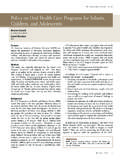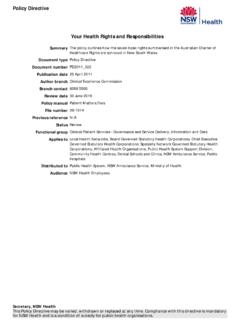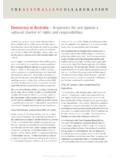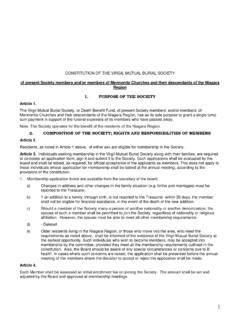Transcription of Policy on a Patient’s Bill of Rights and …
1 146 ORAL HEALTH POLICIES146414 O4 RAL HLERRRRTRPIRCR SRoRRRRRunRCRucReview Council Council on Clinical AffairsReaffirmed 2014 PurposeThe American Academy of Pediatric Dentistry (AAPD) recognizes that pediatric oral health care should be rendered under conditions that are acceptable to both patient and dentist. The expectation is that oral health care providers, their staff, and patients /parents will support this Policy , thereby enhancing patient Policy was developed by the Council on Clinical Affairs and adopted in 2009. This document is based on a systematic literature search of the PubMed /MEDLINE database using the terms: patient freedoms, patient s bill of Rights , bill of Rights , Consumer bill of Rights ; fields: all; limits: within the last 10 years and English. Eighty-one articles met these criteria. Papers for review were chosen from this list and from the references within selected articles.
2 Documents of health care and public Policy organizations relating to the concept of patient Rights and responsibilities also were AAPD is the leader in representing the oral health interests of infants, children, adolescents, and persons with special health care Effective oral health care requires collabora- tion between patients /parents and pediatric dentists and other health care professionals. Open and honest communication, respect for personal and professional values, and sensitivity to differences are integral to optimal patient delivery of contemporary pediatric oral health care many times can be confusing to parents. It is normal for par-ents whose children have planned oral health care treatment to have a set of expectations about the proposed care. Likewise, it is desirable for these parents to have a clear understanding of their responsibilities in the delivery of care to their children.
3 A Patient s bill of Rights is a statement of the Rights to which patients are entitled as recipients of medical/dental care. These Rights can be exercised on the patient s behalf by a parent or legal guardian if the patient is a minor, lacks decision-making capacity, or is legally incompetent. It articu- lates the positive Rights that health care providers and facilities should provide patients , thereby providing information, offering fair treatment, and granting them autonomy over medical collaborative nature of health care requires that patients , or their families/surrogates, participate in their care. The effectiveness of care and patient satisfaction with the course of treatment depend, in part, on the patient s fulfilling certain responsibilities. As such, the AAPD proposes this Policy on a Patient s bill of Rights and Responsibilities in the planning and delivery of pediatric oral health care.
4 The AAPD encourages oral health care providers to tailor this bill of Rights and Responsibilities to their patient community by translating and/or simplifying it as may be necessary to ensure that patients and their families understand their Rights and responsibilities. bill of rightsThese Rights can be exercised on the patient s behalf by a parent or legal guardian if the patient is a minor, lacks decision-making capacity, or is legally incompetent. The patient has the right to: a dental home that provides comprehensive, considerate, and respectful care. have oral health diagnoses made by a dentist. a choice of oral health care provider. The parent has a right to designate a pediatric dentist as a primary oral health care provider for the child. participate fully in all the decisions related to his/her care.
5 Receive accurate, relevant, current, and easily-understood information concerning diagnosis, treatment, and prog- nosis. The patient is entitled to the opportunity to discuss and request information related to the specific procedures and/or treatments, the risks involved, and the medically reasonable alternatives and their accompanying risks and benefits. Life threatening emergency care could be an exception. make decisions about the plan of care prior to and during the course of treatment, to refuse a recommended treatment or plan of care to the extent permitted by law, and to be informed of the health consequences of this action. In case of such refusal, the patient is entitled to other appropriate care and services that the pediatric dentist offers or to transfer to another dentist.
6 Policy on a Patient s bill of Rights and ResponsibilitiesABBREVIATION AAPD: American Academy Pediatric Dentistry. AMERICAN ACADEMY OF PEDIATRIC DENTISTRY ORAL HEALTH POLICIES 147 consent to or decline to participate in proposed research studies affecting care and treatment or requiring direct patient involvement and to have those studies explained fully prior to consent. A patient who declines to partici- pate in research is entitled to the most effective care that the pediatric dentist can otherwise provide. expect reasonable continuity of care. emergency care for acute dental trauma and odonto- genic infections, as needed. know the identity, education, and training of the providers involved in his/her care, as well as when those involved are students, residents, or other trainees. know the immediate and long-term financial implications of treatment choices, insofar as they are known.
7 The patient has the right to be informed of the charges for services and available payment methods. be informed of the provider s policies and practices that relate to patient care, treatment, and responsibilities. The patient has the right to be informed of available re- sources for resolving disputes, grievances, and conflicts, such as ethics committees, patient representatives, or other mechanisms available in an organization. every consideration of privacy. Case discussion, consul- tation, examination, and treatment should be conducted so as to protect each patient s privacy. expect that all communications and records pertaining to his/her care will be treated as confidential, except in cases such as suspected abuse and public health hazards when reporting is permitted or required by law. The patient has the right to expect that the provider will emphasize the confidentiality of information released to other parties entitled to review this information.
8 Review the records pertaining to his/her medical care and to have the information explained or interpreted as necessary, except when restricted by law. The patient has the right to request amendments to his/her record. ask and be informed of the existence of business rela- tionships among institutions, other health care providers, or payers that may influence the patient s treatment and of responsibilitiesThese responsibilities can be exercised on the patient s behalf by a parent or legal guardian if the patient is a minor, lacks decision-making capacity, or is legally incompetent. The patient is responsible for providing, to the best of his/her knowledge, accurate and complete information about past illnesses, hospitalizations, medications, and other matters related to his/her health status. The patient must take responsibility for requesting additional information or clarification about his/her health status or treatment when he/she does not fully understand information and instructions.
9 The patient is responsible for his/her actions if he/she refuses treatment or does not follow the instructions of the provider. It is the patient s responsibility to inform dentists and other caregivers of anticipated problems in following prescribed treatment, including follow-up treatment instructions. The patient has a responsibility to keep appointments and when unable to do so, to notify the dental office as soon as possible. The patient is responsible for being considerate of the Rights of other patients and health care workers and for not interfering with the general functioning of the facility. The patient is responsible for providing accurate in- surance information and for accepting the financial obligations associated with the services rendered. References 1. American Academy of Pediatric Dentistry.
10 AAPD vision statement. Pediatr Dent 2008;29(suppl):3. 2. American Hospital Association. A Patient s bill of Rights . American Heart Association 1992. Catalog no. 157759. 3. President s Advisory Commission on Consumer Protec- tion and Quality in the Health Care Industry. Consumer bill of Rights and Responsibilities, 1998. Washington, July 17, 1998. Available at: gov/hcqual/ . Accessed June 6, 2014.















